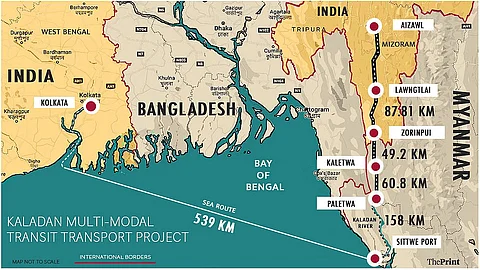
- Home
- Live Blog
- Breaking News
- Top Headlines
- Cities
- NE News
- Sentinel Media
- Sports
- Education
- Jobs

Flagging of a cargo ship from Kolkata to Myanmar’s Sittwe Port has brightened hopes for putting the Kaladan Multimodal Transit Transport Project (KMTTP) back on the rails. The ship carrying 20,000 bags containing 1,000 metric tonnes of cement is scheduled to reach the Sittwe Port on Monday. The development comes close on the heels of Bangladesh issuing permanent transit order allowing Indian ships to use its two sea ports- Chittagong and Mongla- for transporting goods to and fro northeast region. India using sea ports in Bangladesh and Myanmar will unlock trade and commerce potential of the northeast region. India getting access to these sea ports is also of vital strategic importance as alternate routes to connect to border-states in the region in the event of any geopolitical emergency in the neighbourhood. While the Sittwe port had already been completed and ready for operation, it is the road segment in Myanmar of the multimodal project, the completion of the construction of which is critical to facilitate seamless connectivity to Mizoram-Myanmar border. The port on the Western coast of Myanmar is connected through a 158-km river channel along the Kaladan River from Sittwe to Paletwa while a 109-km-long highway is to connect Paletwa with Zorinpui on the India-Myanmar border in Mizoram. Navigability of the river channel along the Kaladan River and capacity of the inland water transport port at Paletwa will remain a key issue for commercial sustainability of the multimodal project after commissioning. On the Indian side, expansion of the national highway connecting Zorinpui with Lawngtlai town in Mizoram is almost complete and will soon be ready for use. Construction of the Zorinpui to Paletwa segment of the trans-border highway inside Myanmar has been delayed by prevailing armed conflict and clashes in the country. Return of peace, stability and democracy in the neighbouring country is crucial for India’s connectivity push via the Sittwe Port to gather momentum. The KMTTP was initiated in 2008 and was originally targeted to be completed by 2014 but delay points towards complexities in trans-border projects. India and Myanmar remaining committed to the project despite stumbling on multiple roadblocks demonstrates the deepening bilateral ties between the two neighbouring countries. Operationalization of the projects can unlock tremendous opportunities of trade, commerce, education, health for people living in remote border regions of the both the countries lack of which is a key factor behind regional disparity between these regions and the mainstream areas of two countries. Better connectivity facilitates the bilateral trade and commerce creating more employment avenues and livelihood opportunities. The maritime routes through sea ports in Bangladesh and Myanmar will facilitate faster transportation of goods from the rest of India to the northeast region. The north-eastern region is visualizing the opportunities of these trans-border connectivity projects to capture the markets of its agricultural and horticultural produce, handloom and textile products, cane and bamboo products, varieties of spices, etc. so that it does not remain a region dependent on supplies from other regions. The challenge for the region is to ensure that it does not miss the bus of becoming self-sufficient and creating new economic opportunities for the people by leveraging the advantages of these connectivity projects. Progress of India’s first multimodal logistics park at Jogighopa in Assam is an encouraging development. Apart from using sea ports, India’s deepening ties with Bangladesh has facilitated use of the river routes in the neighbouring country to revive inland water transport connecting the northeast region with the rest of India for trade, commerce and tourism. Given the scale of economic opportunities, optimal use of sea ports and river routes through Bangladesh as well as Sittwe port in Myanmar may not appear to be attractive from the investors’ point of view. However, these trans-border connectivity projects have also opened up opportunities for trade and commerce among other south Asian and southeast Asian countries and such multilateral ties have enhanced sustainability hopes. Bangladesh and Bhutan and Bangladesh and Nepal have signed Memorandum of Understanding for bilateral trade and commerce through the northeast region utilizing the inland water and maritime routes through northeast region. Such economic cooperation has also bolstered sub-regional unity with India playing the crucial role in strengthening bilateral and multilateral relation among the countries in South and Southeast Asia. Smaller countries in the neighbourhood have found India as a reliable and trustworthy partner and this has increased India’s strategic importance in the neighbourhood. Myanmar being India’s crucial link to Southeast Asia under the Act East policy, Kaladan project will remain a key focus area for India. Northeast having its own roadmap to utilize the sea ports and river routes in Bangladesh and Myanmar has become an urgent necessity. The Ministry of Development in North Eastern Region, North Eastern Council, PSUs, industry associations holding stakeholder consultations in collaboration with state governments and central ministries will help finalize the roadmap.